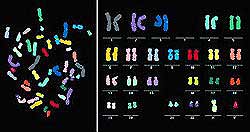Chromosome

Chromosomes
This would only possible with a good winding and folding technique.
Each cell in our body contains a lot of DNA. In fact, If you were to roll out the 46 DNA threads of a human cell and tie them together, they would be two meters long.
The cell nucleus is two hundred times smaller than a pinhead. Therefore the DNA threads will only fit into the cell nucleus if they are well wound and folded!
The chromosomes are the space-savers in the nucleus. They consist of scaffolding composed of proteins, around which a gene thread is wound up. It is a space-saving folding system, which shows just how tightly a thin thread can be wound up – especially immediately before the division of a cell.
Before a cell undergoes division, its DNA threads have to be very compact in order to be transported and to be divided between the two developing “daughter cells”. Figuratively speaking, one could compare this to having papers spread out on one's desk which one wants to deposit in a briefcase in a compact way in order to take it somewhere.
In this compact state, chromosomes are easily colored. This is where the name chromosome comes from (greek: “krom” = color), and the colored chromosomes can even be seen under a microscope.
After the cell division, the chromosomes stretch out again. In other words, the cell spreads out its papers on the desk again so that the genetic information can be read more easily. Each time the DNA information is to be read, the DNA strand has to partially unfold from its supportive scaffolding.
Different organisms have different numbers of chromosomes. A gold fish has 94, humans have 46 and a cauliflower has 18 chromosomes.
Two chromosomes, respectively, are alike in shape and size; they are existent as pairs. A human being inherits 46 chromosomes, 23 from each parent: One of each pair comes from the mother (the ovum), and the other from the father (the sperm).